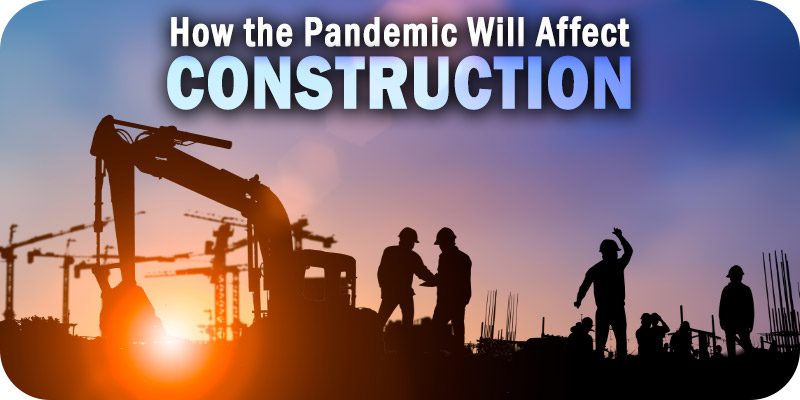How the Pandemic Will Affect the Construction Ecosystem


As part of Solutions Review’s Contributed Content Series—a collection of articles written by industry thought leaders in maturing software categories—Rick Veague, Chief Technology Officer, North America at IFS, explains how the COVID-19 pandemic has become a key catalyst for technology adoption in the construction ecosystem.
Construction is the largest industry in the global economy, accounting for 13% of the world’s GDP. Tight profit margins, poor project delivery performance, and low levels of customer satisfaction have plagued the construction ecosystem for years. With the global pandemic adding to these longstanding industry pressures, the time is ripe for this traditional sector to embrace the benefits of digital modernization.
Construction companies were on the frontline during the pandemic, with the need to develop medical facilities and other essential infrastructure. But for an industry that relies heavily on manual labor and on-site workers, the sudden site closures, new safety measures, and need for more remote employees have presented significant challenges.
Research suggests that the global construction sector decreased by 3.1% in 2020, its worst decline since the 2008 global financial crisis, but the problems didn’t stop there. Today, projects have resumed, but many are being impacted by global supply chain disruptions, worker shortages, and skyrocketing material prices, particularly on lumber and steel. These issues are set to continue into the foreseeable future.
Widget not in any sidebars
If there were ever a time for construction to modernize, it would be now. As sites begin to reopen and projects ramp up, technologies such as artificial intelligence (AI), IoT, and digital twins, underpinned by Enterprise Resource Planning (ERP) systems, will be critical to the industry’s recovery. According to McKinsey’s research, the mandate for change and technology adoption in construction has never been stronger. It says the pandemic serves “to provide additional urgency to the pre-existing productivity and data-visibility issues facing construction companies.”
The pandemic has been a critical tipping point for companies looking to adapt traditional processes and address long-term inefficiencies within the construction ecosystem. Digital innovations from this crisis—IoT sensors and robotic drones, alongside existing enterprise software such as ERP systems—will help companies improve health and safety measures, standardize modular construction, and create a more sustainable building environment.
First, use on-site digital touchpoints to prioritize workplace safety.
As construction companies continue to comply with pandemic restrictions, technology has been essential to implementing health and safety measures. For instance, firms can use wearables and AI sensors to detect when workers are not maintaining a proper physical distance. Some construction projects are even using contact tracing devices that alert employees when there are too many personnel at a worksite and can identify potentially infected individuals in a confirmed COVID-19 case. These measures prioritize employee safety and help companies avoid complete site shutdowns, ensuring both profit margins and tight project deadlines stay on track.
Even remotely, technology is a vital asset to construction firms. With less personnel allowed on-site, companies can rely on new cloud-based video platforms to assist with site monitoring. For instance, in Miami, virtual inspections of construction sites through either a Zoom or a Microsoft Teams video calls are now routine between engineers on-site and building control officials.
With usage tripling in 2020 alone, drones are also being used more frequently to improve mapping and surveying processes. With their advanced capabilities, drones can create a digital record of the site to inform project timelines—allowing all stakeholders to monitor progress safely while also enhancing the accuracy, speed, and ease of projects.
Then, build in controlled environments with modular construction 2.0
Modern methods of construction (MMCs) offer many benefits over traditional options and are a big part of why the construction ecosystem was able to adapt during the pandemic. In particular, modular construction—the process of prefabricating modules and components or even entire homes in a manufacturing facility and then shipping to the site—allowed many construction companies to continue operations in a safe, secure, and controlled way.
While this construction method is not new, the development of digital planning and production technologies has seen adoption rates increase as more companies look to remain operational despite pandemic restrictions. This ability to enable more standardization across the building process allows construction firms to actively address the severe productivity problems affecting the quality and delivery pace of construction projects. For instance, McKinsey predicts that offsite construction can increase the speed of construction by as much as 50% and reduce costs if done in the right environment by 20%.
Now you’re ready to lay the data foundation for a net-zero future.
As of late, customers have become more sustainability-conscious than before and place more significant pressure on companies to reduce the amount of carbon embedded in new construction. However, it doesn’t stop there—consumers are also urging companies to support the growth of a deconstruction industry that reuses huge existing stockpiles of construction material. Here, constructions businesses can rely on ERP systems to help them maintain, recondition, recycle, and support construction materials over an extended lifecycle. This task will not be easy as, according to the World Green Building Council, the building and construction sectors are responsible for 39% of all carbon emissions globally.
Recent McKinsey research suggests the global conversation about climate change, exemplified by the implementation of UN sustainability targets, will compel construction companies and material suppliers to factor sustainability into their products, construction processes, and designs. However, the fragmented and project-based nature of the construction sector creates additional challenges for the adoption of sustainable practices—and this is where enterprise software can make a difference.
Smart buildings and infrastructure that integrate the Internet of Things (IoT) can increase data availability and enable more efficient operations and new business models, such as performance-based and collaborative contracting. For instance, companies can use IoT sensors and communication technology to track and monitor energy efficiency and maintenance needs.
With BIM (Building Information Modelling), construction companies can create a virtual 3-D model with precise transparency on all components used in a completed building, increasing efficiency. Technology is set up to be a key player in helping companies better manage building life cycles and significantly reduce carbon footprints.
The mandate for technological change has been issued, and it’s up to construction firms to act.
Companies throughout the construction ecosystem must change their strategies, business models, and operating models to manage the recent industry disruptions. The pandemic has provided a catalyst for industry-wide changes, but it’s up to construction firms to adapt and transition away from traditional processes. Only those construction businesses willing to use technology and transform how they work for the future by fast-tracking digital transformation and optimizing digital skills to become more efficient will stay ahead of the competition and outlast the pandemic disruptions.

























